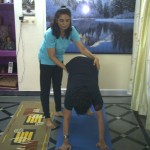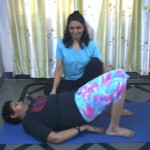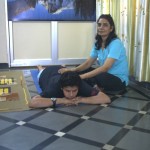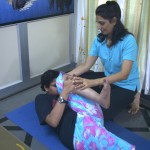- Home
- About Us
- Archived 2002 Home Page
- Privacy Policy Statement
- Resources for Teachers
- Teacher Training Intensive
- Courses & Products
- Teacher Courses
- Upgrade Courses
- E-Courses
- E-Books
- Books
- CDs
- DVDs
- Kits
- Apparel
- Class Packages
- Onsite Intensives
- Onsite Yoga Teacher Training
- White Glove Services
- Testimonials
- Testimonials Page 1
- Testimonials Page 2
- Testimonials Page 3
- Testimonials Page 4
- Testimonials Page 5
- Testimonials Page 6
- Video Testimonials Page 1
- Prenatal Testimonials
- Yoga Community
- Benefits of using Aura’s Yoga Teacher Training Forum
- No Cost Membership
- The Benefits of Online Yoga Teacher Training
- Yoga Teacher Training Blog
- Yoga Teacher Training FAQs
- Yoga Teacher Training Forum
- Yoga Teacher Training Newsletter Archives
- Yoga Teacher Training Podcasts
- Yoga Teacher Video Resource Center
- Yoga Practice Blog
- Terms of Use – Articles
 By Dr. Rita Khanna
By Dr. Rita Khanna
Yoga has its role to play in the lives of people of all ages and nationalities. However it has particular benefit for those who are disabled because it works on three levels-the physical, the mental, spiritual and maintains an integrated development. For physical health, Yogasanas and Pranayama can be often utilized to improve sluggish blood circulation in defective limbs, to improve and stimulate nerve functions and to develop weak muscles and bring them under conscious control. For mental health, Yoga definitely helps disabled children to realize their potential and to lead creative, productive lives, so that they can be of maximum use to themselves, their families and society as a whole because they have brilliant minds and the capacity to reach the highest degree levels.For spiritual health, though in spirit there is no disability whatsoever still through Yoga many disabled people come to realize that there is much more to their nature than the limitations imposed upon them by a mere physical defect.
HOW TO TEACH THEM YOGA
Let’s begin the class:
Warming up:
Form a circle and start with music, songs or kirtan, just about anything.
Yogasanas:
 Now begin in a circle on the floor, lying on the back, then move onto the side, to the front, into Vajrasana, to seated Asanas and then to the standing position. Transition from one level to the other can be quite challenging for some. Being in a circle creates a feeling of unity, trust and connection, and enables you to observe all quite easily.
Now begin in a circle on the floor, lying on the back, then move onto the side, to the front, into Vajrasana, to seated Asanas and then to the standing position. Transition from one level to the other can be quite challenging for some. Being in a circle creates a feeling of unity, trust and connection, and enables you to observe all quite easily.
You participate in many of the Asanas so that students can be visually reminded of that Asana. Moving around the class and assisting when needed either physically (with permission) or verbally is a technique frequently used.
Balancing Asanas can also be attempted in a circle, holding each other’s hands or shoulders for support. This enables success for most and a feeling of being part of the group even if unable to balance.
You keep the classes similar from week to week so that students become familiar with the Asanas, and this has been beneficial in ways. The students should be encouraged to do regular exercise and should often do the Yoga Asanas they have learned.
The following Asanas can be emphasized throughout the class as many of the students have larger bodies and need to keep moving the joints in particular.
Exercise 1: Toe Bending
Assume the sitting posture with legs stretched directly in front of the body. Place the hands on the floor by the side of the trunk. Lean backward, taking support on the straight arms. Become aware of the toes.
Move the toes of both feet slowly backward and forward, keeping the feet rigid. Repeat 10 times.
Exercise 2: Ankle Bending
Remain in the base position as in exercise 1. Move both feet backward and forward as much as possible, bending them from the ankle joints. Repeat 10 times.
Exercise 3: Ankle Rotation
Remain in the base position as in exercise 1. Separate the legs, keeping them straight. Keep the heels in contact with the floor. Rotate the right foot clockwise about the ankle. Repeat 10 times.
Rotate the right foot in the same way, but anticlockwise. Repeat 10 times. Repeat the same procedure with the left foot. Then rotate both feet together.
Exercise 4: Ankle Crank
Assume the base position. Place the right ankle on the left thigh. With the assistance of the left hand, rotate the right foot clockwise 10 times then anticlockwise 10 times.
Repeat the same procedure with the left foot.
Exercise 5: Knee Bending
Assume the base position. Bend the right leg at the knee and clasp the hands under the right thigh. Straighten the right leg without allowing the heel or toe to touch the ground. Keep the hands under the right thigh but allow the arms to straighten. Bend the right leg as much as possible at the knee, bringing the heel near the right buttock. Repeat 10 times.
Now repeat the same procedure with the left leg.
Exercise 6: Dynamic Spinal Twist
Assume the base position. Separate the legs as much as is comfortable. Keeping the arms straight, bring the right hand to the left big toe and stretch the left arm behind the back. Keep both arms in one straight line. Turn the head and look backward, directing the gaze to the left hand. Turn the trunk in the opposite direction; bring the left hand to the right big toe and stretch the right arm behind. This is one round. Repeat 10 or 20 times.
At the beginning, do the exercise slowly, then gradually increase the speed.
Exercise 7: Half Butterfly
Assume the base position. Fold the right leg and place the right foot on the left thigh. Place the left hand on the left knee and the right hand on top of the bent right knee. Gently move the bent leg up and down with the right hand, allowing the muscles of the leg to relax as much as possible. Continue this exercise until the right knee starts to touch or nearly touch the floor.
Repeat the same process with the left knee.
After some days or weeks of practice, the knee should comfortably rest on the floor without effort.
Exercise 8: Full Butterfly – i
In the base position, bring the soles of the feet together. Try to bring the heels as close to the body as possible. Interlock the fingers and place them under the foot. Gently push the knees towards the ground, utilizing the elbows, and bend the body forward. Try to touch the ground with the head; this will be difficult initially.
Exercise 8: Full Butterfly – ii
Keeping the soles of the feet together, place the hands on the knees. Utilizing the arms, push the knees towards the ground, allowing them to bounce upward again. Repeat 20 or more times.
Exercise 8: Full Butterfly-iii
Maintain the same position, but place the hands on the floor behind and to the side of the back, keeping the arms straight. Move the knees up and down 20 times or more.
Exercise 9: Hand Clenching
Hold the arms straight out in front of the body, so that they are on the same horizontal plane as the shoulders. Stretch and tense the fingers of both hands. Close the fingers over the thumbs to make a tight fist. Again stretch and tense the fingers. Repeat this movement10 times.
Exercise 10: Wrist Bending
Maintain the same position as in exercise 9. Bend the hands at the wrist, as if you are pressing the palms against a wall. From the upward pointing of the fingers, bend the hands at the wrist and point the fingers downward. Again point the fingers upward. Repeat 10 times.
Exercise 11: Wrist Joint Rotation
Stay in the same position as in exercise 10, but with only the right hand extended. Clench the right fist and rotate it clockwise 10 times about the wrist. Then rotate the fist anti-clockwise 10 times. Repeat the same movement with the left hand.
Extend both arms in front of the body with the fists clenched. Rotate the fists together, 10 times clockwise and then 10 times anti-clockwise.
Exercise 12: Elbow Bending
Maintain the same position as in 11, but hold both arms outstretched with the hands open and the palms upwards. Bend both arms at the elbows, touch the shoulders with fingers and then straighten the arms again. Repeat 10 times.
Exercise 12: Variation-i
Perform the same exercise but with the arms extended sideways- Repeat 10 times.
Exercise 13: Shoulder Socket Rotation
Stay in the same position as in exercise 12, variation-i. Make a circular movement from the shoulder joints, keeping the fingers in contact with the shoulders. Repeat 10 times clockwise, then 10 times anti-clockwise. Try to make the circular movement of each elbow as large as possible, bringing the two elbows in contact with each other in front of the chest.
Exercise 14: Neck Movement-i
Assume the base position. Slowly move the head backwards and forwards 10 times.
Exercise 14: Neck Movement-ii
Slowly tilt the head to the left and to the right, first while facing directly forward and then while turning the head to the left and right. Repeat both methods 10 times.
Exercise 14: Neck Movement-iii
Slowly rotate the head in as large a circle as possible, 10 times clockwise and then 10 times anticlockwise. Do not strain.
Some more Asanas:
 Utthanpadasana, Chakrapadasana, Pada Sanchalanasana, Naukasana, Shavasana, Gatyatmak Meru Vakrasana (Dynamic spinal twist), Chakki Chalana, Nauka Sanchalana, Vajrasana, Marjariasana, Vyaghrasana, Shashankasana, Ushtrasana, Shashank Bhujangasana, Makarasana. Asanas help to remove extra fat from the abdomen, hips and thighs. Have fun with many of the Asanas as they are based on animal movements, and sounds of those animals are sometimes heard. Even Bhramari Pranayama sound (humming bee breath) is very popular with the students. At the end of each term you provide an opportunity for students to demonstrate their favourite Asana and have the others join them.
Utthanpadasana, Chakrapadasana, Pada Sanchalanasana, Naukasana, Shavasana, Gatyatmak Meru Vakrasana (Dynamic spinal twist), Chakki Chalana, Nauka Sanchalana, Vajrasana, Marjariasana, Vyaghrasana, Shashankasana, Ushtrasana, Shashank Bhujangasana, Makarasana. Asanas help to remove extra fat from the abdomen, hips and thighs. Have fun with many of the Asanas as they are based on animal movements, and sounds of those animals are sometimes heard. Even Bhramari Pranayama sound (humming bee breath) is very popular with the students. At the end of each term you provide an opportunity for students to demonstrate their favourite Asana and have the others join them.
As they age, gain weight and lose some mobility, chairs can be brought in and postures can be modified. Students have various ‘conditions’, including Down’s Syndrome, autism, epilepsy and other unknown disabilities. Their abilities range from being able to perform most of the Asanas to attempting some, or relaxing when unable to move into them.
Pranayama:
 Pranayama consists of Bhramari, Nadi shodhana (alternate nostril breathing) and abdominal breathing. A form of Nadi shodhana is sometimes performed from Makarasana (crocodile pose), by lifting one leg as they breathe in, lowering the leg as they breathe out, and changing legs alternately. It is also an excellent practice for coordination, for lower back problems and stimulating correct breathing.
Pranayama consists of Bhramari, Nadi shodhana (alternate nostril breathing) and abdominal breathing. A form of Nadi shodhana is sometimes performed from Makarasana (crocodile pose), by lifting one leg as they breathe in, lowering the leg as they breathe out, and changing legs alternately. It is also an excellent practice for coordination, for lower back problems and stimulating correct breathing.
As many are mouth breathers, emphasis is placed on breathing with the mouth closed, head up and a slower breath. Upper respiratory tract infections are common so encouragement to keep the mouth closed is beneficial.
Yoga Nidra:
End each session with Yoga nidra. Music can be played quietly in the background during this time as it helps them with settling. In the beginning, Yoga nidra should start for about five minutes, as it is all the time they could lie still. Then it can be done for about ten to fifteen minutes. Keeping language simple is essential for the body rotation stage. Visualizations involve familiar aspects of nature, such as walks at the beach, exploring a park or bush and rural settings. By the end of the hour session, the students will leave in a more relaxed state than when they had entered.
Benefits:
 I’ve noticed the following since I started classes with these special groups of people :-
I’ve noticed the following since I started classes with these special groups of people :-
An increase in flexibility in many; a willingness to try anything; an ability to remember many of the Asanas and the order we often do them in; an increased awareness of their body parts; being able to breathe more slowly and deeply in some of the classes and becoming calmer by the end of each session.
I would encourage Yoga teachers to take on the experience of teaching disabled clients as no matter how you feel, they are sure to bring you into the moment totally, to make you smile and laugh. An attitude of fun, love, trust, perseverance and patience is needed when conducting these classes and has a tenfold reward. Their Aum chanting is a special gem in the lotus!
Aum Shanti
If you feel inspired by this article, feel free to publish it in your Newsletter or on your Website. Our humble request is to please include the Resource as follows: –
Courtesy: Dr. Rita Khanna’s Yogashaastra Studio.
A popular studio that helps you find natural solutions for complete health.
Also conducts online Yoga Courses & Naturopathy Guidance.
Mobile: + 919849772485
Ph:-91-40-65173344
Email: yogashaastra@gmail.com
Website: www.yogashaastra.in
Dr. Rita Khanna
Dr. Rita Khanna is a well-known name in the field of Yoga and Naturopathy. She was initiated into this discipline over 25 years ago by world famous Swami Adyatmananda of Sivananda Ashram in Rishikesh (India).
She believes firmly that Yoga is a scientific process, which helps us to lead a healthy and disease-free life. She is also actively involved in practicing alternative medicines like Naturopathy. Over the years, she has been successfully practicing these therapies and providing succour to several chronic and terminally ill patients through Yoga, Diet and Naturopathy. She is also imparting Yoga Teachers Training.
At present, Dr. Rita Khanna is running a Yoga Studio in Secunderabad (Hyderabad, India).


Yoga brings a lot of benefits for human being for all disabled or not.